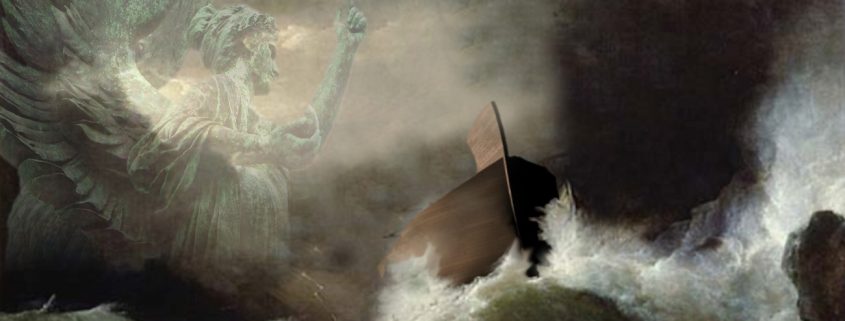The big question we didn’t address in last month’s article is why cranial deformation—headshaping—was even a thing. Please understand that I’m not suggesting that these 6,000 year-old coneheads were genetic mutations or Nephilim, the angel-human hybrids mentioned in Genesis 6 (although the Nephilim would have been around during at least part of the time that headshaping was common in the ancient Near East). But who wakes up one morning in 7000 B.C. and decides to wrap something around baby’s skull to see if it makes his head pointy?
What inspires that? And why was Eridu, the first city in ancient Sumer (and thus possibly the oldest city in the world), the starting point for this?
A study published in the academic journal Paléorient in 1992 concluded that the practice of head-shaping, which is found around the world, originated in the Near East because it was so widespread there. However, the researchers believed the deformation was not necessarily intentional, but probably “incidental to patterns of head-gear.”3
Really? For more than six thousand years our ancestors accidentally forced their babies to wear head-gear so tight it deformed their skulls?
Here’s another bit of data to chew on. At Eridu and nearby sites in ancient pre-flood southern Sumer, and only there, archaeologists have found about 120 terracotta figurines they call “ophidian.” That’s fancy talk for snake-like. They’re slender bipeds, adorned with button-like protuberances, more often female than male, and often in poses that are exclusively mammalian—for example, a female lizard-like figure suckling an infant.
Ophidian figurines made from terracotta and bitumen. Female found at Ur in 1931, male at Eridu in 1948-49. Drawing of female based on object #31-16-733 at Penn Museum; male figurine was on display at the National Museum of Iraq.
The aforementioned scholars pointed out in their paper that there had been no serious study of those figurines and what they meant to the ancients, and no scholarly literature on the origins of human cranial deformation (at least as of their writing in 1992).
Why might that be?
While there hasn’t been much scholarly attention paid to the snake-like figurines, there have been several papers published within the last ten years on head-shaping in the ancient Near East. Still no conclusions on why or how it got started, but it’s clear that the people who lived in the region—descendants of the refugees from Eden—made a habit of this odd practice.
We’ll never know for sure, but we can speculate: The people who formed the earliest human civilizations copied a look that someone, somewhere had seen and decided was a physical ideal. What motivates modern-day teens to wear the clothes and hairstyles they do? Except that this particular fashion statement didn’t change with the seasons—it appears to have been worn by nearly everybody for more than 6,000 years!
It’s not likely that this was a simple fashion statement. However it started, this was apparently a practice that was believed to convey some advantage.
Think back to what we discussed about the serpentine nachash and seraphim, and remember that at least one of them rebelled against Yahweh. Is it possible that the citizens of the prehistoric Near East were trying to curry favor with what they believed was a god?
#
Now, if we haven’t already, here is where we may run off the rails. But let’s run through one more theory, look at the evidence, and see if it makes sense.
As mentioned earlier, Eridu is considered by archaeologists to be the center of the Ubaid culture. The Ubaid period is defined as the civilization in the ancient Near East just before the time of Nimrod and the Tower of Babel, roughly between 6500 B.C. and 3800 B.C. It would have begun not long after Adam and Eve got kicked out of the garden.
Now, God wanted humanity to “have dominion over the fish of the sea and over the birds of the heavens and over every living thing that moves on the earth” (Genesis 1:28). It was not for His people to take dominion over each other. As Jesus told his disciples thousands of years later, “You know that the rulers of the Gentiles lord it over them, and their great ones exercise authority over them. It shall not be so among you” (Matthew 20:25-26a).
Just as Adam and Eve were created to work the land, God’s design for humans was to be more or less self-sufficient—growing our own food, tending our own flocks, and helping each other whenever and however we’re needed. When you live that kind of life, you’re too busy to lord it over your neighbors. And, frankly, since you’re not depending on handouts for your family’s daily bread, it’s harder for government to lord it over you. It makes sense that Israel was led by judges in times of trouble during its early years, but a king wasn’t part of the original plan—even though God, who knows the end from the beginning, surely saw what was coming and let the Hebrews make Saul king anyway.
Earlier, we described the main features of the Ubaid civilization. Archaeologists and sociologists have noticed two other things that emerged during the Ubaid period—first, it was a transition from a rural to an urban society, and second, society became increasingly stratified.
In other words, the evidence—things people were buried with, mainly—shows that as people moved from the country to the city, the rich got richer and the poor got poorer.
This period also saw the construction of the first temples in Mesopotamia. Each city apparently had a temple for its own local god. And each temple had a granary for collecting the offerings of the commoners. Of course, this means somebody oversaw who gave how much, and—more importantly—who received how much. Archaeologists and sociologists believe this led to an elite class of hereditary leaders, who may have been the ones doling out the grain from temple granaries.
Substitute income tax and social security control over the grain harvest and rationing, and it’s clear that things haven’t changed all that much in the last 8,000 years. But I digress.
It’s fair to ask how this situation came about. We can only speculate since we don’t have any written records to study. Logically, though, it’s a pretty good guess that entities who’d rebelled against Yahweh at this early stage had set themselves up as gods. It’s conceivable, based on what we know about angels from the Bible, that one or more of them appeared to the pre-Sumerians and encouraged certain candidates who were receptive to the idea that 1) the gods needed temples, and 2) the temples required priest-kings to oversee offerings and ensure that the gods were pleased. The result was a civilization where freedom was restricted to the upper class while the peasants worked the land to support them.
We’re speculating, of course, but from the standpoint of the Fallen, breaking civilization into classes was a brilliant PSYOP. Destroying the world is much easier when you only have to manipulate a handful of useful idiots who can convince the rest to do things your way.
Scholars who study the Ubaid period have concluded that it was a time of increasing disparity between the classes, but they don’t look at the situation through a spiritual lens. It happened, but why? They analyze factors like climate and technology, but they ignore the possibility that the unseen realm may have guided those changes.
God’s original design was for people to work the land and live free. As Christians, who should accept the existence of the spirit realm by default, it should be natural for us to ask whether the lesser elohim might have rebelled against Yahweh’s plan for creation, and if so, how that would play out. If we don’t, you can bet secular historians, archaeologists, and anthropologists won’t bother.
Since the trend during the Ubaid period was toward ever-larger villages with temples of the gods at the center of everyday life, contrary to God’s command to “multiply and fill the earth,” it’s a fair guess that this change was the work of entities who were disloyal to their Creator—and who wanted to destroy the work that He’d called very good.
3 Solecki, Rose; Akkermans, Peter M. M. G.; Agelarakis. Anagnostis; Meiklejohn, Christopher; Smith, Philip E.L. “Artificial cranial deformation in the Proto-neolithic and Neolithic Near East and its possible origin: Evidence from four sites,” Paléorient, 1992, vol. 18, no. 2, pp. 83-97.

Derek Gilbert Bio
Derek P. Gilbert hosts SkyWatchTV, a Christian television program that airs on several national networks, the long-running interview podcast A View from the Bunker, and co-hosts SciFriday, a weekly television program that analyzes science news with his wife, author Sharon K. Gilbert.
Before joining SkyWatchTV in 2015, his secular broadcasting career spanned more than 25 years with stops at radio stations in Philadelphia, Saint Louis, Little Rock, and suburban Chicago.
Derek is a Christian, a husband and a father. He’s been a regular speaker at Bible prophecy conferences in recent years. Derek’s most recent book is The Great Inception: Satan’s PSYOPs from Eden to Armageddon. He has also published the novels The God Conspiracy and Iron Dragons, and he’s a contributing author to the nonfiction anthologies God’s Ghostbusters, Blood on the Altar, I Predict: What 12 Global Experts Believe You Will See by 2025, and When Once We Were a Nation.





Leave a Reply
Want to join the discussion?Feel free to contribute!